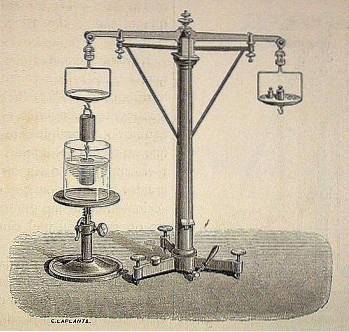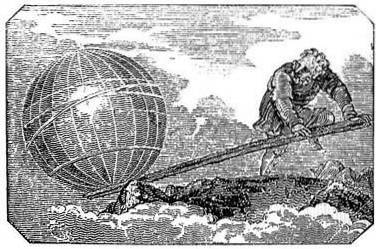
Archimedes Biography, Contributions and Inventions
Archimedes of Syracuse (287 BC - 212 BC) was a Greek mathematician, physicist, inventor, engineer and astronomer from the ancient city of Syracuse, on the island of Sicily. His most outstanding contributions are the Archimedes principle, the development of the exhaustion method, the mechanical method or the creation of the first planetarium..
He is currently considered one of the three most important figures in ancient mathematics along with Euclid and Apollonius, since their contributions meant important scientific advances for the time in the areas of calculus, physics, geometry and astronomy. In turn, this makes him one of the most prominent scientists in human history..

Despite the fact that few details of his personal life are known -and those that are known are of doubtful reliability-, his contributions are known thanks to a series of letters written about his work and achievements that have been preserved to this day, belonging to to the correspondence that he maintained for years with friends and other mathematicians of the time.
Archimedes was famous in his time for his inventions, which attracted much attention from his contemporaries, in part because they were used as war devices to successfully prevent numerous Roman invasions..
However, it is said that he claimed that the only thing really important was mathematics, and that his inventions were merely the product of the hobby of applied geometry. In posterity, his works in pure mathematics have been much more appreciated than his inventions..
Article index
- 1 Biography
- 1.1 Training
- 1.2 Scientific work
- 1.3 Conflict in Syracuse
- 1.4 Death
- 2 Scientific contributions of Archimedes
- 2.1 Archimedes' principle
- 2.2 Mechanical method
- 2.3 Explanation of the lever law
- 2.4 Development of the exhaustion or depletion method for scientific demonstration
- 2.5 The measure of the circle
- 2.6 The geometry of spheres and cylinders
- 3 Inventions
- 3.1 The odometer
- 3.2 The first planetarium
- 3.3 The Archimedean screw
- 3.4 The Claw of Archimedes
- 4 References
Biography
Archimedes of Syracuse was born in approximately 287 BC. Not much information is known about his early years, although it can be said that he was born in Syracuse, a city considered the main seaport of the island of Sicily, today in Italy.
At that time, Syracuse was one of the cities that made up the so-called Magna Grecia, which was the space inhabited by settlers of Greek origin towards the southern area of the Italian peninsula and in Sicily..
No specific information is known about Archimedes' mother. In relation to the father, it is known that this was called Phidias and that he was dedicated to astronomy. This information about his father is known thanks to a fragment of the book The sand counter, written by Archimedes, in which he mentions his father's name.
Heraclides, who was a Greek philosopher and astronomer, was close friends with Archimedes and even wrote a biography about him. However, this document has not been preserved, so all the information contained therein is unknown..
On the other hand, the historian, philosopher and biographer Plutarch indicated in his book entitled Parallel Lives that Archimedes had a blood relationship with Hiero II, a tyrant who was in command in Syracuse since 265 BC..
Training
As a result of the little information we have about Archimedes, it is not known for sure where he obtained his first training..
However, various historiographers have determined that there is a high possibility that Archimedes studied in Alexandria, which was the most important Greek cultural and teaching center in the region..
This assumption is supported by information provided by the Greek historian Diodorus Siculus, who indicated that Archimedes probably studied in Alexandria.
In addition, in many of his works, Archimedes himself makes mention of other scientists of the time whose work was concentrated in Alexandria, so it can be assumed that he actually developed in that city.
Some of the personalities with whom Archimedes is believed to have interacted in Alexandria are the geographer, mathematician, and astronomer Eratosthenes of Cyrene, and the mathematician and astronomer Conon de Sanos..
Family motivation
On the other hand, the fact that Archimedes' father was an astronomer may have had a notable influence on the inclinations that he subsequently demonstrated, because later on and from a young age, a special attraction towards the field of science was evidenced in him. Sciences.
After his time in Alexandria, it is estimated that Archimedes returned to Syracuse.
Scientific work
After returning to Syracuse, Archimedes began to devise different artifacts that very soon made him gain some popularity among the inhabitants of this city. In this period he gave himself completely to scientific work, produced various inventions and deduced various mathematical notions well ahead of his time..
For example, by studying the characteristics of solid curved and plane figures, he came to raise concepts related to the integral and differential calculus, which was developed later.
Likewise, Archimedes was the one who defined that the volume associated with a sphere corresponds to twice the size of the cylinder that contains it, and he was the one who invented the compound pulley, based on his discoveries about the law of the lever..
Conflict in Syracuse
During the year 213 BC Roman soldiers entered the city of Syracuse and surrounded its settlers in order to make them surrender..
This action was led by the Greek military and politician Marco Claudio Marcelo in the framework of the Second Punic War. Later, it was known as the Sword of Rome, since it ended up conquering Syracuse.
In the midst of the conflict, which lasted two years, the inhabitants of Syracuse fought against the Romans with courage and ferocity, and Archimedes played a very important role, since he dedicated himself to creating tools and instruments that would help defeat the Romans..
Finally, Marco Claudio Marcelo took the city of Syracuse. Before the great intelligentsia of Archimedes, Marcelo ordered in an exhaustive way that they not hurt or kill him. However, Archimedes was killed at the hands of a Roman soldier.
Death
Archimedes died in 212 BC. More than 130 years after his death, in 137 BC, the writer, politician and philosopher Marco Tulio Cicero occupied a position in the administration of Rome and wanted to find the tomb of Archimedes.
This task was not easy, because Cicero could not find anyone to indicate the precise location. However, he eventually got it, very close to the Agrigento gate and in deplorable condition.
Cicero cleaned the tomb and discovered that a sphere was inscribed inside a cylinder, as a reference to the discovery about the volume that Archimedes made some time ago..
Versions about his death
First version
One version states that Archimedes was in the middle of solving a mathematical problem when he was approached by a Roman soldier. It is said that Archimedes may have asked him for a little time to solve the problem, so the soldier would have killed him.
Second version
The second version is similar to the first. It tells that Archimedes was solving a math problem when the city was taken.
A Roman soldier entered his compound and ordered him to go meet Marcelo, to which Archimedes replied saying that first he had to solve the problem he was working on. The soldier got upset as a result of this answer and killed him.
Third version
This hypothesis indicates that Archimedes had in his hands a great diversity of mathematical instruments. Then a soldier saw him and thought he might be carrying valuable items, so he killed him.
Fourth version
This version illustrates that Archimedes was crouched close to the ground, contemplating some plans that he was studying. Apparently a Roman soldier came from behind and, unaware that it was Archimedes, shot him.
Scientific contributions of Archimedes
Archimedes principle

The Archimedean principle is considered by modern science as one of the most important legacies of the Ancient era.
Throughout history, and orally, it has been transmitted that Archimedes arrived at his discovery accidentally thanks to King Hieron commissioning him to check if a gold crown, ordered to be made by him, was made only of gold pure and did not contain any other metal. I had to do this without destroying the crown.
It is said that while Archimedes was meditating on how to solve this problem, he decided to take a bath, and when he entered the bathtub, he realized that the water level increased when he submerged himself in it..
In this way, he would come to discover the scientific principle that states that "every body totally or partially submerged in a fluid (liquid or gas) receives an upward thrust, equal to the weight of the fluid dislodged by the object".
This principle means that fluids exert an upward force - which pushes up - on any object submerged in them, and that the amount of this pushing force is equal to the weight of the liquid displaced by the submerged body, regardless of its weight..
The explanation of this principle describes the phenomenon of flotation, and is found in its Treatise on floating bodies.
Archimedes' principle has been enormously applied in posterity for the flotation of objects of massive use such as submarines, ships, life preservers and hot air balloons..
Mechanical method
Another of Archimedes' most important contributions to science was the inclusion of a purely mechanical -that is, technical- method in the reasoning and argumentation of geometric problems, which meant an unprecedented way of solving this type of problem for the time..
In the context of Archimedes, geometry was considered as an exclusively theoretical science, and the common thing was that from pure mathematics it was descended towards other practical sciences in which its principles could be applied..
For this reason, today it is considered as the forerunner of mechanics as a scientific discipline.
In the writing in which the mathematician exposes the new method to his friend Eratosthenes, he indicates that it allows us to address questions of mathematics through mechanics, and that in a certain way it is easier to construct the proof of a geometric theorem if it is already has some prior practical knowledge, that if you have no idea about it.
This new research method carried out by Archimedes would become a precursor to the informal stage of discovery and hypothesis formulation of the modern scientific method..
Explanation of the lever law

Although the lever is a simple machine that was used long before Archimedes, it was he who formulated the principle that explains its operation in his treatise On the balance of planes.
In formulating this law, Archimedes establishes principles that describe the different behaviors of a lever when placing two bodies on it, depending on their weight and their distance from the point of support..
In this way, he points out that two bodies capable of being measured (commensurate), located on a lever, balance when they are at distances inversely proportional to their weight..
In the same way, immeasurable bodies do (which cannot be measured), but this law was provable by Archimedes only with bodies of the first type.
His formulation of the principle of the lever is a good example of the application of the mechanical method, since as he explains in a letter addressed to Dositeo, it was discovered at first through the methods of mechanics that he put into practice..
Later he formulated them using methods of geometry (theoretical). This experimentation on bodies also gave rise to the notion of center of gravity..
Development of the exhaustion or exhaustion method for scientific demonstration
The exhaustion is a method used in geometry that consists of approximating geometric figures whose area is known, by means of the inscription and circumscription, over some other whose area it is intended to know.
Although Archimedes was not the creator of this method, he did develop it masterfully, managing to calculate by means of it a precise value of Pi.
Archimedes, using the exhaustion method, inscribed and circumscribed hexagons to a circumference of diameter 1, reducing to an absurdity the difference between the area of the hexagons and that of the circumference..
To do this, he bisected the hexagons creating polygons with up to 16 sides, as shown in the previous figure..
In this way, he came to specify that the value of pi (of the relationship between the length of a circumference and its diameter) is between the values 3.14084507… and 3.14285714… .
Archimedes masterfully used the exhaustion method because it not only managed to approach the calculation of the value of Pi with a fairly low margin of error, and therefore, desired-, but also, because Pi is an irrational number, through This method and the results obtained laid the foundations that would germinate in the infinitesimal calculus system, and later, in the modern integral calculus.
The measure of the circle
To determine the area of a circle, Archimedes used a method that consisted of drawing a square that fit exactly inside a circle.
Knowing that the area of the square was the sum of its sides and that the area of the circle was greater, he began to work on obtaining approximations. He did this by substituting a 6-sided polygon for the square and then working with more complex polygons.
Archimedes was the first mathematician in history to come close to making a serious calculation of the number Pi.
The geometry of spheres and cylinders
Among the nine treatises that compile the work of Archimedes in mathematics and physics, there are two volumes on the geometry of spheres and cylinders.
This work deals with the determination that the surface of any sphere of radius is four times that of its largest circle, and that the volume of a sphere is two-thirds that of the cylinder in which it is inscribed..
Inventions
Odometer
Also known as the kilometer counter, it was an invention of this famous man.
This device was built based on the principle of a wheel that when it rotates activates gears that allow the distance traveled to be calculated.
According to this same principle, Archimedes designed various types of odometers for military and civil purposes.
The first planetarium
Based on the testimony of many classic writers such as Cicero, Ovidio, Claudiano, Marciano Capela, Cassiodoro, Sexto Empirico and Lactantcio, today many scientists attribute to Archimedes the creation of the first rudimentary planetarium.
It is a mechanism made up of a series of "spheres" that managed to imitate the movement of the planets. So far the details of this mechanism are unknown.
According to Cicero, the planetariums built by Archimedes were two. In one of them the earth and the various constellations near it were represented.
In the other, with a single rotation, the sun, the moon and the planets carried out their own and independent movements in relation to the fixed stars in the same way as they did on a real day. In the latter, in addition, successive phases and eclipses of the moon could be observed.
Archimedean screw
The Archimedean screw is a device used to transport water from the bottom up through a slope, by means of a tube or cylinder.
According to the Greek historian Diodorus, thanks to this invention the irrigation of fertile lands located along the Nile River in ancient Egypt was facilitated, since traditional tools required an immense physical effort that exhausted the workers.
The cylinder used has inside a screw of the same length, which maintains interconnected a system of propellers or fins that perform a rotary movement driven manually by a rotating lever.
In this way, the propellers manage to push any substance from the bottom up, forming a kind of infinite circuit.
Archimedes claw
Archimedes' claw, or the iron hand as it is also known, was one of the most fearsome weapons of war created by this mathematician, becoming the most important for the defense of Sicily from Roman invasions.
According to research by Drexel University professors Chris Rorres (Department of Mathematics) and Harry Harris (Department of Civil Engineering and Architecture), it was a large lever that had a grappling hook attached to the lever. by means of a chain that hung from it.
Through the lever the hook was manipulated so that it fell on the enemy ship, and the objective was to hook it and raise it to such an extent that when releasing it it would be able to overturn it completely, or make it crash against the rocks on the shore..
Rorres and Harris presented at the Symposium "Extraordinary Machines and Structures of Antiquity" (2001), a miniature representation of this artifact entitled "A formidable war machine: Construction and operation of Archimedes' iron hand"
To carry out this work they relied on the arguments of the ancient historians Polybius, Plutarch and Tito Livio..
References
- ASSIS, A. (2008). Archimedes, the center of gravity, and the first law of mechanics [online]. Accessed June 10, 2017 on bourabai.ru.
- DIJKSTERHUIS, E. (1956). Archimedes [online]. Retrieved June 9, 2015 on the World Wide Web: books.google.co.ve/books.
- MOLINA, A. (2008). The Research Method of Archimedes of Syracuse: Intuition, Mechanics and Exhaustion [online]. Consulted on June 10, 2017 in the World Wide Webproduccioncientifica.luz.edu.
- O'CONNOR, J. & ROBERTSON, R. (1999). Archimedes of Syracuse [online]. Retrieved June 9, 2017 from history.mcs.st-and.ac.uk.
- PARRA, E. (2009). Archimedes: his life, works and contributions to modern mathematics [online]. Retrieved June 9, 2017 from lfunes.uniandes.edu.co.
- QUINN, L. (2005). Archimedes of Syracuse [online]. Retrieved June 9, 2017 from math.ucdenver.edu.
- RORRES, C. & HARRIS, H. (2001). A Formidable War Machine: Construction and Operation of Archimedes' Iron Hand [online]. Retrieved June 10, 2017 from cs.drexel.edu.
- VITE, L. (2014). Archimedes' Principle [online]. Retrieved June 10, 2017 from repository.uaeh.edu.mx.



Yet No Comments